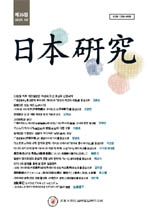- 영문명
- Kana Notations of the Rhyme Group Xiao(效) in Various Editions of the Shyubun-Inryaku
- 발행기관
- 고려대학교 글로벌일본연구원
- 저자명
- 안동니(Dong-ni An) 이경철(Kyung-chul Lee)
- 간행물 정보
- 『일본연구』第44輯, 415~437쪽, 전체 23쪽
- 주제분류
- 인문학 > 문학
- 파일형태
- 발행일자
- 2025.08.31

국문 초록
본고는 『취분운략』의 4개 본(문명판, 원록판, 보력판, 연보판)에 나타나는 효섭운(效攝韻)의 자음형을 대상으로, 한음자료와 오음자료를 비교하여 분석하였다. 이를 통해 효섭운의 각 운별 자음형의 계통적 분포 및 판본 간 차이를 체계적으로 검토하였다. 결과를 정리하면 다음과 같다.
1. 개구1등 호(豪)운은 주로 -au형으로 나타나는데, -au형은 오음한음 동형이므로 오음인지 한음인지 구별할 수 없다. 단지 그 성모를 통해 니모의 [タウ猱腦惱碯], [ダウ峱], 명모의 [ホウ耄芼媢冒旄瑁]는 한음으로, 니모의 [ナウ腦惱碯]는 오음으로 규정할 수 있다.
2. 개구2등 효(肴)운은 주로 한음의 -au형으로 나타나며 일부 -eu형으로 출현한 것은 오음의 혼입으로 볼 수 있다.
3. 개구3등 소(宵)운 을류는 주로 -eu형으로 출현하여, 한음인지 오음인지 구별할 수 없지만, 명모의 [メウ貓]는 오음의 혼입으로 볼 수 있다.
4. 개구3등 소(宵)운 갑류는 주로 -eu형으로 출현하여 한음인지 오음인지 구별할 수 없지만, 명모의 [メウ描苗渺妙], 일모의 [ネウ繞遶饒嬈]는 오음으로 규정할 수 있다.
5. 개구4등 소(蕭)운 주로-eu형으로 출현하며 일부 -au형, -jou형이 혼재한다. 그 자음형으로는 오음과 한음을 구별할 수 없지만, 니모의 [ネウ尿褭嬈]는 오음으로 규정할 수 있다.
영문 초록
This study investigated the kana notations in the four editions of the Shyubun -Inryaku, comparing them with the direct reading data of Go'on and Kan'on, as well as differences in Sino-Japanese kana notations within the rhyme group Xiao(效). The key findings are as follows.
1) First rhyme Hao(豪) : Annotated with the -au type, showing no distinction between Go'on and Kan'on. However, characters with the initial Ni(泥), such as [タウ猱腦惱碯], [ダウ峱], and [ホウ耄芼媢冒旄瑁], are associated with Kan'on, while [ナウ腦惱碯] with the same initial is categorized as Go'on.
2) Second rhyme Yao(肴) : Primarily marked as Kan'on(-au type), but interspersed with Go'on(-eu type), indicating Go'on influence.
3) Third rhyme Xiao(宵) : B type: Annotated with the -eu type, making distinctions between Go'on and Kan'on challenging. Characters like [メウ貓] with the initial Ming(明) are identified as Go'on. A type: Annotated with the -eu type. Characters such as [メウ描苗渺妙] (initial Ming 明) and [ネウ繞遶饒嬈] (initial Ri 日) are categorized as Go'on.
4) Fourth rhyme Xiao(蕭) : Annotated with the -eu type, with occasional occurrences of -au and -jou types. Characters like [ネウ尿褭嬈] with the initial Ni(泥) are noted as Go'on.
5) General findings : The kana annotations across all four rhyme groups in Shyubun-Inryaku predominantly align with Kan'on, though traces of Go'on influence are evident.
This research highlights the complexity of phonological distinctions in Sino- Japanese kana notations and provides insights into the interplay between Go'on and Kan'on within the Shyubun-Inryaku.
목차
Ⅰ. 머리말
Ⅱ. 개구1등 호(豪)운
Ⅲ. 개구2등 효(肴)운
Ⅳ. 개구3등 소(宵)운 을류
Ⅴ. 개구3등 소(宵)운 갑류
Ⅵ. 개구4등 소(蕭)운
Ⅶ. 맺음말
참고문헌
해당간행물 수록 논문
참고문헌
- 일본오음연구
- 일본연구
- 일어일문학연구
- 일본학연구
- 비교일본학
- 일본학보
- 일어일문학연구
- 일어일문학연구
- 일본문화연구
- 일본문화연구
- 일본문화연구
- 일본어학연구
- 日本文化硏究
- 일본언어문화
- 일본어학연구
- 일본어문학
- 일어일문학연구
- 동북아문화연구
- 일본학연구
- 일본연구
- 日本近代學硏究
- 일본연구
- 일본학보
- Studies in Humanities and Social Sciences
- 일본학보
- 인문사회과학연구
- 名古屋大学人文科学研究
- 青山国際政経論集
최근 이용한 논문
교보eBook 첫 방문을 환영 합니다!

신규가입 혜택 지급이 완료 되었습니다.
바로 사용 가능한 교보e캐시 1,000원 (유효기간 7일)
지금 바로 교보eBook의 다양한 콘텐츠를 이용해 보세요!



